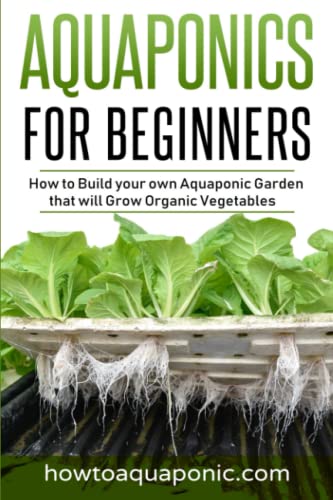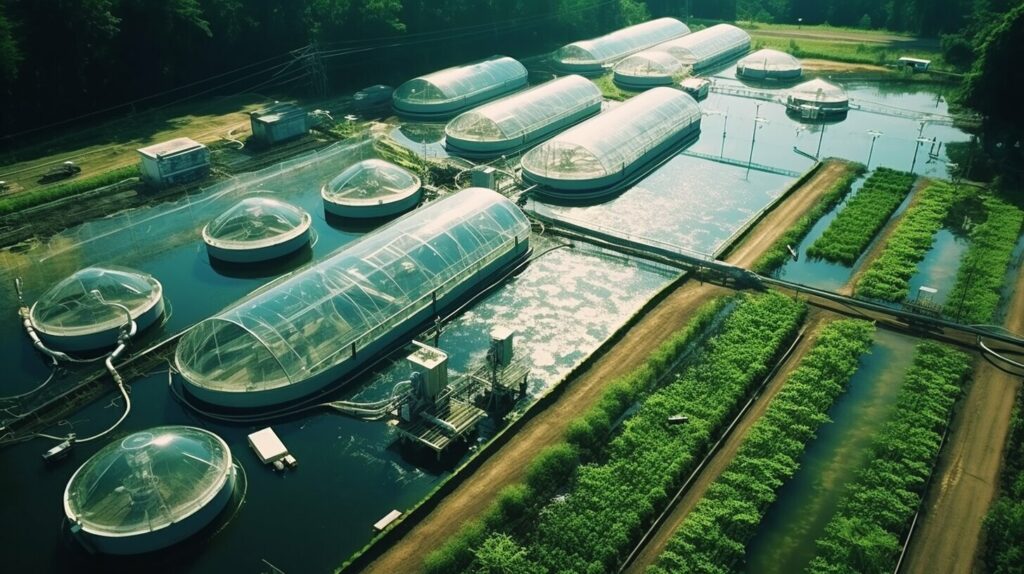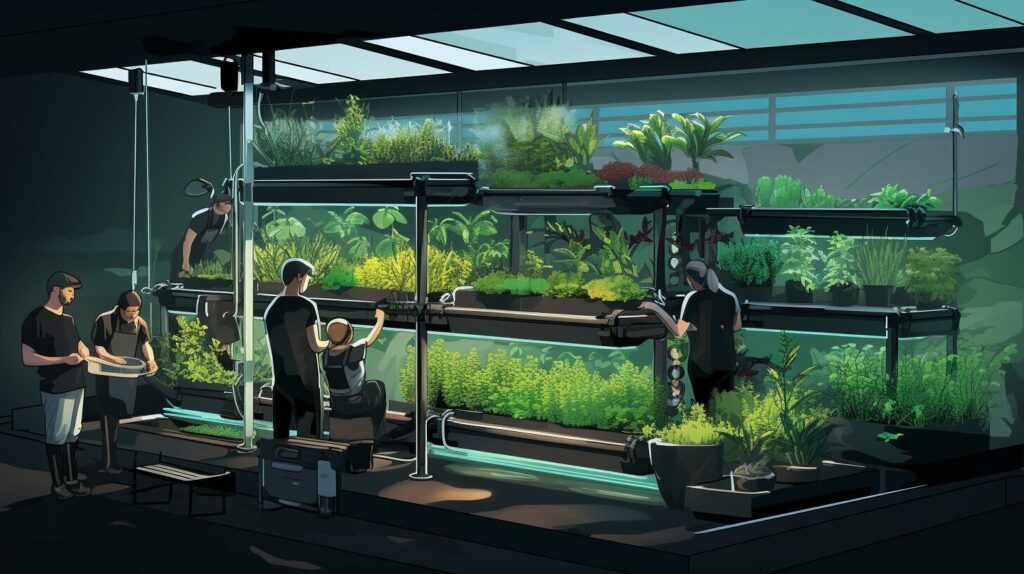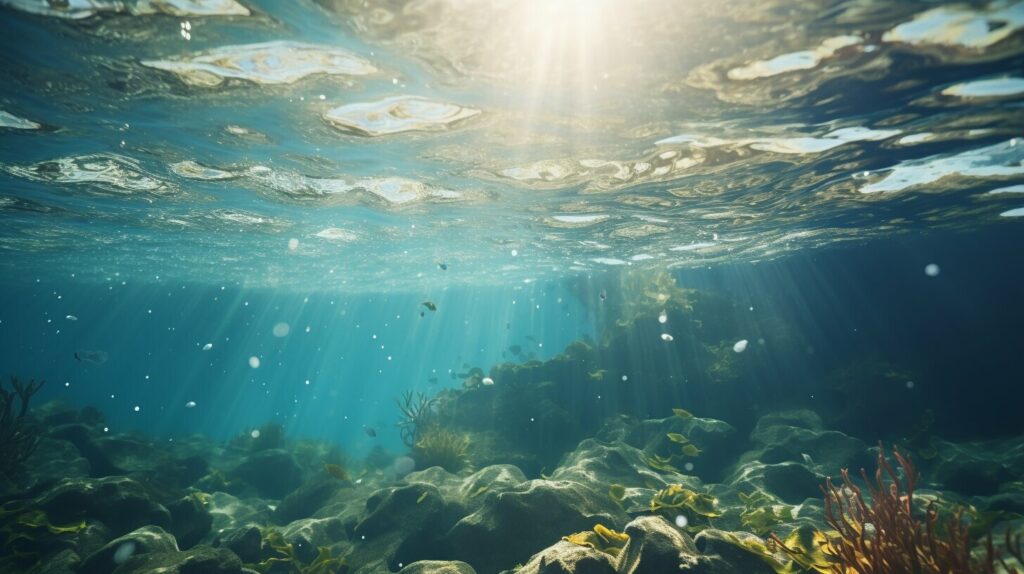This post may contain affiliate links and we may earn a small commission when you click on the links at no additional cost to you. As an Amazon Affiliate, we earn from qualifying purchases. You can read our full disclaimer here.
Suppose you’re looking for a sustainable and efficient way to grow your food. In that case, aquaponics might be the solution you’ve been searching for. We have books on aquaponics for beginners to recommend, too!
Aquaponics is the process of combining aquaculture and hydroponics to create a mutually beneficial relationship. The plants filter the water for the fish by utilizing the nutrients provided by fish waste. This closed-loop system requires less water and fertilizer than traditional farming methods. It can be done in a small space, making it ideal for urban environments.
When it comes to aquaponics for beginners, there are a few things to consider before getting started. First, you’ll need to decide what system you want to build. There are several types, including media-based, deep water culture, and nutrient film techniques. Each has pros and cons, so it’s essential to research and choose the one that best fits your needs and budget.
Another vital factor is the type of fish and plants you want to grow. Some fish, like tilapia and trout, are better suited for aquaponics than others. Similarly, some plants, like lettuce and herbs, thrive in this system, while others may struggle. Understanding which fish and plants are compatible and how to maintain a healthy balance between them is crucial to the success of your aquaponics system.
Aquaponics is a sustainable and efficient way to grow your own food that combines aquaculture and hydroponics. Before getting started, consider the type of system you want to build and the fish and plants you want to grow. You can enjoy fresh, organic produce and fish from your backyard with the proper setup and knowledge.
Best Aquaponics for Beginners Books
If you’re new to aquaponics, figuring out where to start can be overwhelming. Luckily, plenty of products are available that can help simplify the process and get you on your way to growing your own food sustainably and eco-friendly. In this article, we’ve compiled a list of the best aquaponics books for beginners so you can easily find everything you need to get started.
Aquaponics for Beginners: How to Build your own Aquaponic Garden that will Grow Organic Vegetables

This book is an excellent resource if you want to start your own aquaponic garden.
Pros
- Provides a step-by-step guide for building your own aquaponic garden
- Includes tips for growing organic vegetables
- Easy to understand and follow
Cons
- Some illustrations are not very clear
- It may not cover more advanced aquaponic techniques
- Only available in English
Aquaponics for Beginners provides a comprehensive guide for starting their own aquaponic garden. The book covers everything from the basics of aquaponics to the step-by-step process of building your own system. It also includes tips for growing organic vegetables and troubleshooting common problems.
One of the best things about this book is how easy it is to understand. The author does a great job of breaking down complex concepts into simple, easy-to-follow steps. Whether you’re a beginner or have some experience with aquaponics, this book is a great resource.
However, some of the book’s illustrations are unclear, which may make it difficult for some readers to follow along. Additionally, the book may not cover more advanced aquaponic techniques, so those looking for more in-depth information may need to look elsewhere. Finally, it’s worth noting that the book is only available in English.
If you want to start your own aquaponic garden, Aquaponics for Beginners is worth checking out. It provides a great introduction to aquaponics and is a valuable resource for growing organic vegetables.
Aquaponics for Beginners: The Ultimate Step-by-step Guide to Building Your Own Aquaponics System

Peter Nishida’s Aquaponics for Beginners is another great book for beginners.
Pros
- Provides a step-by-step guide for building your own aquaponics system
- Teaches you how to maintain and grow various organic vegetables
- Written in an easy-to-understand language
Cons
- Some readers may find the book too basic
- The book doesn’t cover more advanced aquaponics techniques
- The book is only available in paperback format
Aquaponics for Beginners is a comprehensive guide covering everything you need to know to start your own system. The book provides a step-by-step guide for building your system and teaches how to maintain and grow various organic vegetables using aquaponics.
One of the best things about this book is that it’s written in an easy-to-understand language. Even if you have no prior experience with aquaponics, you can follow the instructions and set up your own system.
However, some readers may find the book too basic. If you’re familiar with aquaponics, you may not learn anything new from this book. Additionally, the book doesn’t cover more advanced aquaponics techniques, so if you want to take your system to the next level, you may need to look for additional resources.
Overall, if you’re a beginner looking to start your own aquaponics system, Aquaponics for Beginners is a great resource. It’s easy to understand, provides step-by-step instructions, and teaches how to grow organic vegetables using aquaponics.
Beginner’s Guide to Aquaponics: Step-By-Step Systems for Plants and Fish

Seth Connell’s book is another one that we would recommend for beginners.
Pros
- Provides step-by-step instructions to set up your own aquaponics system
- Offers information on the best plants and fish to use in your system
- Written in an easy-to-understand language
Cons
- Lacks detailed illustrations and photos
- Does not include information on troubleshooting common problems
- Some readers found the book to be too basic
In the Beginner’s Guide to Aquaponics, you’ll learn everything you need to know to set up your system. The book covers the basics of aquaponics, including the benefits of using this system, the different types of aquaponics systems, and the best plants and fish to use in your system. You’ll also find step-by-step instructions for setting up your system, including information on choosing the right location, building it, and maintaining it.
One of the best things about this book is that it’s written in an easy-to-understand language. Even if you’re completely new to aquaponics, you’ll be able to follow along with the instructions and understand the concepts. However, some readers found the book to be too basic and lacking in detail.
One drawback of the book is that it doesn’t include detailed illustrations and photos. Visual aids would enhance the clarity of instructions. Additionally, the book doesn’t offer information on troubleshooting common problems you may encounter while setting up or maintaining your system.
Overall, if you’re looking for a beginner-friendly guide to aquaponics, the Beginner’s Guide to Aquaponics is a great choice. You can set up your system quickly with step-by-step instructions and easy-to-understand language.
Aquaponics: From Beginner to Expert – Hydroponics & Aquaponics Double Book Bundle – Exact Blueprint to Aquaponic & Hydroponic Organic Gardening From Home

Suppose you’re looking for a basic introduction to aquaponics and hydroponics. This book may be a decent starting point, but it falls short of providing detailed and modern techniques for those looking to start their own system.
Pros
- Provides a basic overview of aquaponics and hydroponics
- The double book bundle includes both aquaponic and hydroponic organic gardening techniques
- Good starting point for beginners
Cons
- Lacks detailed and modern techniques for those looking to start their own system
- Some readers found the book to be too basic and not advanced enough
- The information provided is not as in-depth as expected from the product description and reviews
The book covers basic required information but falls short of providing detailed and modern techniques for those looking to start their own system. While some readers found it a good starting point for beginners, others were disappointed with the lack of advanced information. Overall, suppose you’re looking for a basic introduction to aquaponics and hydroponics. This book may be worth considering, but you may want to look elsewhere if you’re looking for more in-depth information.
Aquaponics: An Essential Step-By-Step Guide to Aquaponics for Beginners

This book by Sheila Brown is another great choice.
Pros
- Provides a step-by-step guide for beginners
- Covers a variety of topics related to aquaponics
- Easy-to-understand language
Cons
- Some readers may find the focus on global warming in the first few chapters to be distracting
- All measurements are in metric units
- Some readers found the pictures to be difficult to read
This book covers everything from setting up your system to choosing the right fish and plants. The writing is clear and easy to understand, making it an excellent choice for beginners. However, some readers may find the focus on global warming distracting, and using metric units may confuse those unfamiliar. Additionally, some readers found the pictures to be challenging to read.
Overall, if you’re looking for a comprehensive guide to aquaponics that’s easy to understand, this book is a great choice.
Buying Guide
When buying an aquaponics system, you should consider a few things to ensure you get the best product. Here are some tips to help you make the right decision:
Size and Capacity
The first thing to consider is the size and capacity of the system. You want to ensure it is large enough to support the fish and plants you plan to have. A general guideline is to provide 1 gallon of water per inch of fish. As for plants, you want to have enough grow beds to support them.
Type of System
Three primary types of aquaponics systems are media-based, deep water culture, and nutrient film technique. Each has pros and cons, so it’s important to research which is best for your needs. Media-based systems are great for beginners and can support a variety of plants. Deep water culture systems are ideal for growing leafy greens and herbs. Nutrient film technique systems are great for small spaces and can be used to produce a variety of plants.
Materials
The materials used to construct the system are also important. You want to make sure they are durable and can withstand the elements. Look for systems made of food-grade materials like PVC or HDPE. Avoid systems made of materials that can leach harmful chemicals into the water.
Price
Aquaponics systems can range in price from a few hundred dollars to several thousand dollars. It’s important to set a budget and stick to it. Keep in mind that a higher price doesn’t always mean better quality. Search for affordable systems with the necessary features.
Maintenance
When choosing a system, consider its maintenance requirements. Opt for systems that are easy to clean and maintain. You want to spend more time enjoying your system than maintaining it.
With these factors in mind, you can discover the ideal aquaponics system.
Conclusion
Congratulations! You have completed our beginner’s guide to aquaponics. You now have a basic understanding of aquaponics, how it works, and the essential components of an aquaponic system.
Starting an aquaponic system requires careful planning, research, and investment. However, the rewards of growing fresh and organic produce while raising fish can be worth it.
Here are some key takeaways to keep in mind:
- Aquaponics is a closed-loop system that efficiently and sustainably grows plants and fish.
- The three main components of an aquaponic system are the fish tank, grow bed, and water pump.
- You can choose from various fish and plants to suit your preferences and local climate.
- It is essential to prioritize maintaining water quality to ensure the well-being of both fish and plants. Therefore, regular testing and monitoring are necessary.
- Engaging in aquaponics can be an enjoyable and fulfilling pastime, but it demands dedication, perseverance, and patience.
We hope this guide has helped introduce you to the world of aquaponics. Good luck on your aquaponic journey!



